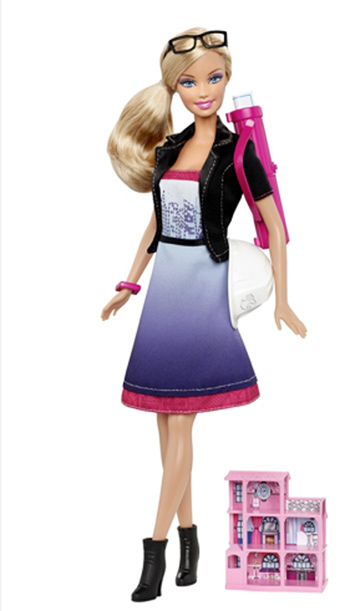
February 18, 2011
Architect Barbie

Architect Barbie. [Image courtesy of Mattel]
Eleven-and-a-half inches tall, made of polyvinyl chloride and synthetic fibers, Barbie made her debut on March 9, 1959, at the big toy fair in New York City.
With her zebra-striped swimsuit and top-knotted ponytail (blonde or brunette, your choice), Barbie looked ready-made for fun. But like her creator Ruth Handler, president of Mattel, she’s a career girl.
Back at the beginning Barbie was a “teenage fashion model.” But she quickly moved on and up, and the resumé is mind-boggling. In the ’60s Barbie was an astronaut, a ballerina, a business executive and a babysitter. In the ’70s, ’80s and ’90s she was surgeon and doctor, gymnast and aerobics instructor, ambassador for world peace and (yes) McDonald’s cashier. Also a paleontologist, a firefighter, and the guest editor of a fashion magazine.
An impressive (and actually only partial) list; and it got longer when Mattel introduced the “I Can Be …” series in 2001, allowing the public to vote for Barbie’s new careers. So lately Barbie’s been a veterinarian, gym coach, swim teacher, racecar driver and rock star. Last year she did a stint as a computer engineer.
But — you’ve probably guessed this by now — in more than 50 years Barbie’s never been an architect.
Until now. Earlier this month at the same big toy fair in NYC where Barbie began, Mattel unveiled Architect Barbie.
Like so many milestones in women’s history, Architect Barbie happened not by chance but by campaign. And the driving force behind the campaign is architectural historian Despina Stratigakos. A professor in the architecture department at SUNY/Buffalo, Stratigakos got interested in Barbie’s curriculum vitae during a fellowship at the University of Michigan, where in 2007 she staged the exhibition Architect Barbie. The author of an award-winning book on women architects in prewar Germany, Stratigakos made the clear connections to a field where, as she wrote in a statement for the Michigan exhibition, “We cannot comfortably claim that the profession’s history of exclusion lies behind us. Although the number of female students averages about 40 percent in Bachelor of Architecture and Master of Architecture programs, these women have not found their way into licensed practice, which remains about 87 percent male …”
But even then Stratigakos had the big prize in view: “As a scholar and educator deeply concerned with making architecture not only relevant to little girls, but also women relevant to architecture, I hope to persuade Mattel to reconsider the viability of Architect Barbie.”
So in the spring of 2010, when Mattel announced that the public would be able to vote on Barbie’s next career — her 125th! — Stratigakos teamed up with Kelly Hayes McAlonie, president-elect of AIA New York State and a biographer of architect Louise Bethune, who practiced in Buffalo at the turn of the 20th century, and was perhaps the first licensed woman architect in the world. Stratigakos and Hayes McAlonie campaigned long and hard, and though Architect Barbie didn’t win, she got so many votes, and from all around the globe, that Mattel asked the two women, both AIA members, to collaborate with them.
And now, according to a post at toyXplosion.com, “There’s a new doll coming to the Barbie I Can Be… line this Fall 2011. … Ready to tackle the daily responsibilities of a real architect in or out of the office, Barbie I Can Be… Architect includes a hard hat and a set of blue prints. …” Mattel describes her outfit — pink and blue dress, black jacket and boots — as “symmetrically stylish with bold colors and clean lines.”
Welcome to architecture, Barbie.
Observed
View all
Observed
By Nancy Levinson
Related Posts

Equity Observer
L’Oreal Thompson Payton|Essays
‘Misogynoir is a distraction’: Moya Bailey on why Kamala Harris (or any U.S. president) is not going to save us

Equity Observer
Ellen McGirt|Essays
I’m looking for a dad in finance

She the People
Aimee Allison|Audio
She the People with Aimee Allison, a new podcast from Design Observer

Equity Observer
Kevin Bethune|Essays
Oh My, AI
Recent Posts
What now? Make a Plan to Vote ft. Genny Castillo, Danielle Atkinson of Mothering Justice Black balled and white walled: Interiority in Coralie Fargeat’s “The Substance”L’Oreal Thompson Payton|Essays
‘Misogynoir is a distraction’: Moya Bailey on why Kamala Harris (or any U.S. president) is not going to save usRelated Posts

Equity Observer
L’Oreal Thompson Payton|Essays
‘Misogynoir is a distraction’: Moya Bailey on why Kamala Harris (or any U.S. president) is not going to save us

Equity Observer
Ellen McGirt|Essays
I’m looking for a dad in finance

She the People
Aimee Allison|Audio
She the People with Aimee Allison, a new podcast from Design Observer

Equity Observer
Kevin Bethune|Essays

 Nancy Levinson is executive director and editor of Places.
Nancy Levinson is executive director and editor of Places.